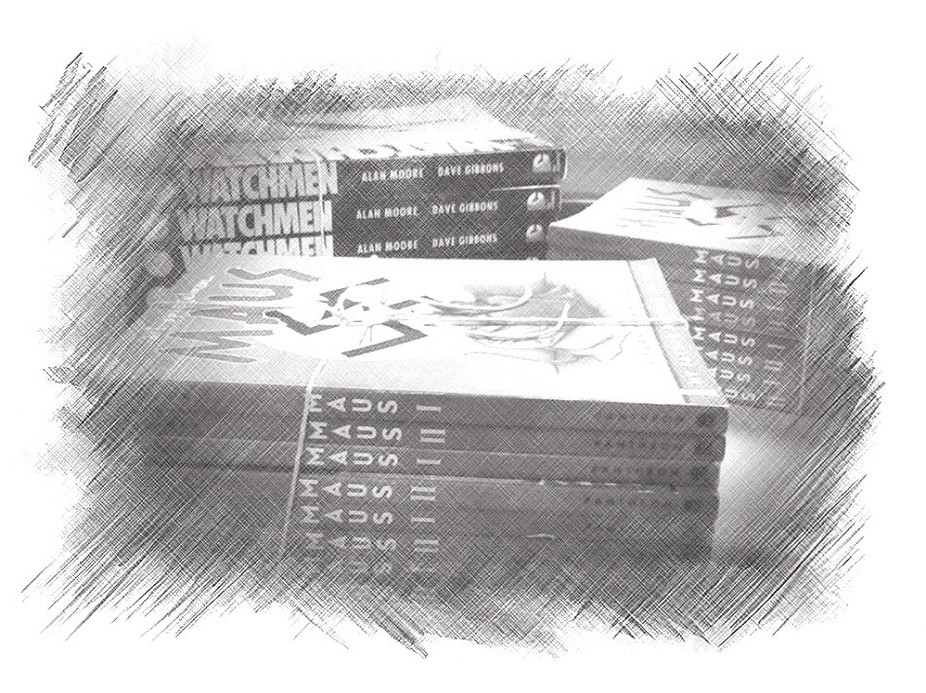From Jan. 26 to 29, hundreds of thousands of people will convene in the French town of Angoulême to celebrate a very specific form of storytelling. The French call it “bandes dessinées,” or “drawn strips.” In America, we’re less sure what we’re supposed to call it. It used to be “comic books,” or “cartoons,” or “the funnies” – silly names for childish entertainments. Now, we say “graphic novels,” with some rolling their eyes at the puffed-up earnestness of the name.
As a creator and academic, I’ve witnessed incredible growth of graphic novels, which have won literature prizes, are exhibited in museums and are stacked on bedside tables. But there are still these odd little dances of nomenclature we have to perform just to talk about them.
A story with a picture
Telling a story with a picture is a very old, very human thing to do. And when one picture doesn’t say quite enough, people will intuitively hit on the idea of putting a second picture next to the first.
You’ll see this in Neolithic cave paintings, Egyptian murals, Greek pottery and Renaissance altarpieces. It’s found in folk traditions as well. During a trip to Peru, I saw lintel beams painted with courtship stories given to newlyweds for their new homes. There are academic forms, like the Japanese scrolls called “emaki.” And there are acts of individual expression, impossible to categorize, distinct from any body of similar work, like the Jewish artist Charlotte Salomon’s painted autobiography, “Life or Theatre?”
The most well-known form of this approach to storytelling came about in the late 19th century, when newspaper publisher James Gordon Bennett wanted to show off his impressive new color lithography presses. He gave a passel of artists free rein to create a children’s supplement for the New York Herald. After a relatively brief period of frenzied experimentation, they developed a set of conventions that let them tell a coherent visual story on a newspaper page. Word balloons, motion lines, visual onomatopoeia, the interaction of narrative blocks and imagery and panel sequence had all been used before. But they were now standardized into a recognizable format: the comic strip.
From its origins as children’s fare, comic strips became synonymous with low-brow, preliterate material. Occasionally, artists would develop higher artistic or literary pretensions and would flail around for a more elevating name to attach to their efforts. As early as the 1930s, people began trying out terms like “picto-fiction,” “sequential art” and “graphic novel.”
And why not? Certainly great works are crafted from both the written word and from the representational image. Why shouldn’t great works come from combining the two? If the name “comic book” had too many associations of childhood and cheap newsprint, it made sense to find a better one.
A name to signal respectability?
“Graphic novel” – used to describe a long-form comic with quality production and literary ambitions – achieved common usage in the 1980s, following the success of Art Spiegelman’s “Maus.” Spiegelman wanted to call his work “commix,” which would have paid homage to the underground comix of the 1960s while emphasizing the “mixed” parts of this mongrel medium – high and low culture, word and picture, art and commerce.
But “graphic novel,” much like “horseless carriage,” made a new thing easier to understand by comparing it with something familiar. It was easily adopted by publishers and booksellers. And it sounded respectable.
Following “Maus,” there was a brief surge of interest from mainstream publishers in graphic novels as literature, but it faltered. There wasn’t enough material that could replicate the success of “Maus.” As millions of unfinished manuscripts on the world’s laptops will attest, wrangling the narrative and thematic complexity of a novel is hard. Making a graphic novel is not a matter of giving a cartoonist a longer page count. It requires consciously building a very demanding suite of skills. It took another generation to achieve the critical mass of creators necessary to sustain consistently vibrant graphic novel market.
In the 2000s, there was a second wave of graphic novels, led by Chris Ware’s “Jimmy Corrigan, Smartest Boy on Earth.” But this time, Ware had the company of a rich cohort. Publishers took a broader approach to comics, looking not just for literary graphic novels but also autobiographies (Satrapi’s “Persepolis”), adaptations (Karasik and Mazzucchelli’s Paul Auster’s “City of Glass”), visual essays (Coe’s “Sheep of Fools”), journalism (Sacco’s “Safe Area Goražde”) and so on. This coincided with the comic books’ most famous child, the superhero, reaching the big screen.
The case for comics
But even as comics have accrued the critical and popular respectability the term sought to emulate, many have begun to buck at the name “graphic novel,” finding it as limiting and prejudicial in its own way as “comic book.”
“Graphic novel” has gone from referring to a specific format to becoming a proxy for all forms of comics. The results can be confusing. A large percentage of graphic novels, for example, are nonfiction. Autobiographies are especially popular. Which is to say, they aren’t actually novels. And what do you call short pieces of a page or two? I once worked with a magazine that wanted to call its comics section “graphic shorts,” which sounded like a pair of cellophane hot pants.
As a creator, I’m less bothered by the pedantry of the term than the expectation it can establish – namely, that long-form comics will be novelistic. A novel is only one way to conceive of an extended narrative, and one that plays heavily to the strengths of text. It may not be the best approach for inherently visual storytelling. Perhaps a given creator is better off structuring her comic like a dance or a puzzlebox or architecture or a song. For that matter, comics have a deep enough history that they can serve as their own model, building on their own formal strengths as a medium in conversation with themselves instead of looking to others. That, after all, is the hallmark of a mature medium.
So what do we call this medium? There really isn’t an ideal choice, but “comics” may be the least-bad one. It’s how you’ll hear most creators referring to their own work. It doesn’t have the polysyllabic grandeur of “graphic novels,” but, with so many extraordinary works of artistic and literary merit available, perhaps we can take the pressure off the name and let the work speak for itself.
 Joel Priddy does not work for, consult, own shares in or receive funding from any company or organization that would benefit from this article, and has disclosed no relevant affiliations beyond the academic appointment above.
Joel Priddy does not work for, consult, own shares in or receive funding from any company or organization that would benefit from this article, and has disclosed no relevant affiliations beyond the academic appointment above.
This article was originally published on The Conversation. Read the original article.



 Glastonbury is as popular than ever, but complaints about the lineup reveal its generational challenge
Glastonbury is as popular than ever, but complaints about the lineup reveal its generational challenge  6 simple questions to tell if a ‘finfluencer’ is more flash than cash
6 simple questions to tell if a ‘finfluencer’ is more flash than cash  Britain has almost 1 million young people not in work or education – here’s what evidence shows can change that
Britain has almost 1 million young people not in work or education – here’s what evidence shows can change that  Locked up then locked out: how NZ’s bank rules make life for ex-prisoners even harder
Locked up then locked out: how NZ’s bank rules make life for ex-prisoners even harder  Can your cat recognise you by scent? New study shows it’s likely
Can your cat recognise you by scent? New study shows it’s likely  The American mass exodus to Canada amid Trump 2.0 has yet to materialize
The American mass exodus to Canada amid Trump 2.0 has yet to materialize  Yes, government influences wages – but not just in the way you might think
Yes, government influences wages – but not just in the way you might think  Every generation thinks they had it the toughest, but for Gen Z, they’re probably right
Every generation thinks they had it the toughest, but for Gen Z, they’re probably right  AI is driving down the price of knowledge – universities have to rethink what they offer
AI is driving down the price of knowledge – universities have to rethink what they offer  Disaster or digital spectacle? The dangers of using floods to create social media content
Disaster or digital spectacle? The dangers of using floods to create social media content  The Beauty Beneath the Expressway: A Journey from Self to Service
The Beauty Beneath the Expressway: A Journey from Self to Service  Why financial hardship is more likely if you’re disabled or sick
Why financial hardship is more likely if you’re disabled or sick  The pandemic is still disrupting young people’s careers
The pandemic is still disrupting young people’s careers 
































